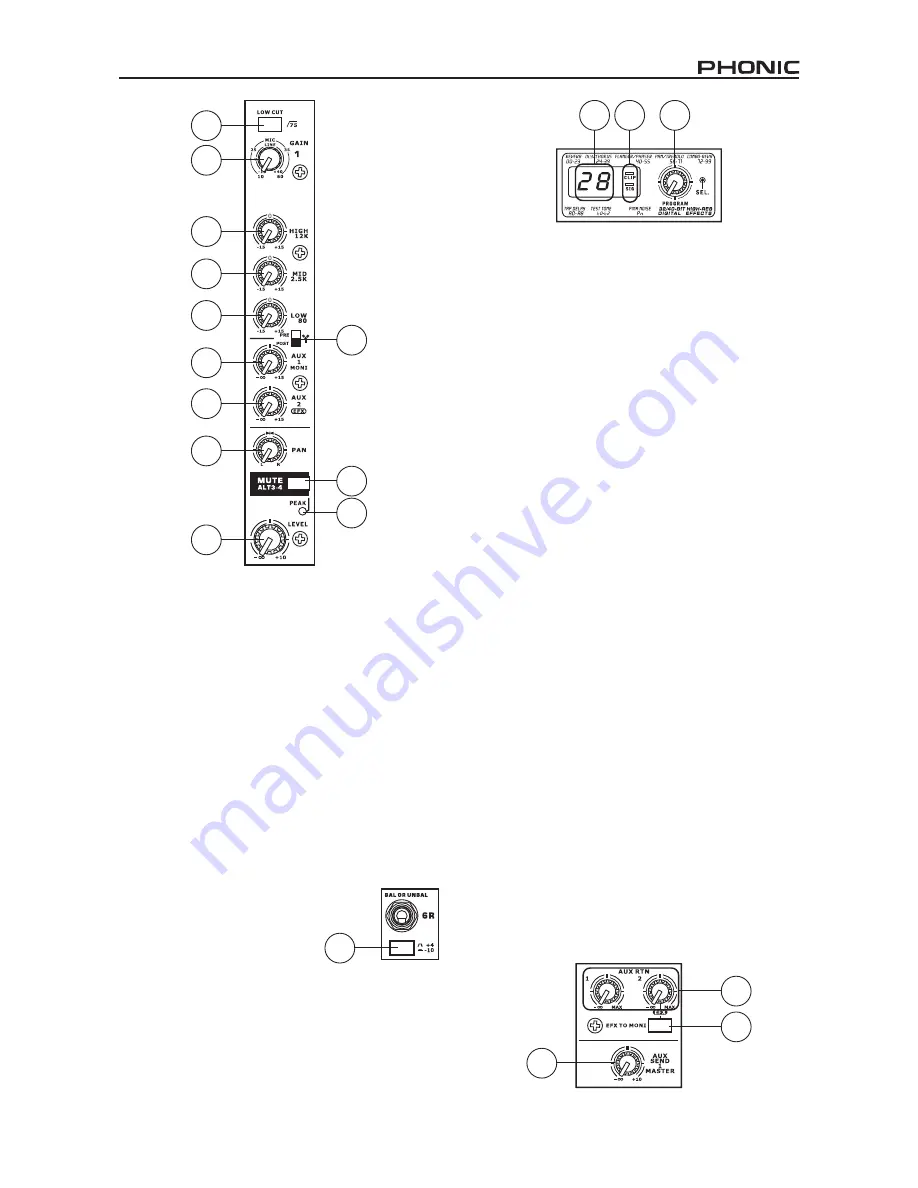
7
HELIX BOARD 12 UNIVERSAL
29. Mute / ALT 3-4
This handy little button is basically a typical mute button –
effectively stopping any signal received by the channel from being
sent to the Main L/R or AUX 2 send mixing buses – however it
does so much more. Pushing this button routes the channel’s
signal away from the Main L/R and to its own “Alternate” stereo
output (Alt 3-4), where the signal can be used at will. If you wish
to use it to connect an amplifier and speakers, or simply patch it
through to an unused input channel, you can easily do so.
30. Peak Indicator
This LED indicator will illuminate when the device hits high peaks,
6 dB before overload occurs. It is best to adjust the gain of the
channel so that the PEAK indicator lights up on intervals only.
This will ensure a greater dynamic range of audio. This LED will
light up while the Mute button is pushed in.
31. Level Control
This rotary control will alter the signal level that is sent from the
corresponding channel to the Main or Alt. 3-4 mixing bus.
32. +4 / -10 Switch
This button, located on both stereo
input channels, is used adjust the
input sensitivity of the corresponding
channels, which will adapt the mixer to
external devices which may use different
operating levels. If the input source is -
10 dBV (consumer audio level), it is best
to engage the switch, allowing the signal to be heard. The +4
dBu level is suitable for Professional Audio signals, which are
considerably higher than the consumer level. However, if you
are unsure of the source’s operating level, we suggest leaving
the switch disengaged until you test the source’s signal. You
can then engage if necessary (if the level of the input signal is
obviously too low).
Digital Effect Section
33. Digital Effect Display
This 2-digital numeric display shows the program number that
is currently applied to your EFX audio signal. When you rotate
the Program control, you can scroll through different program
numbers. The display will revert back to the original program if a
new program is not selected within a few seconds. For a list of
available effects, please observe the Digital Effect Table.
34. Sig and Clip Indicators
Located within the Digital Effect Display are Clip and Sig LEDs.
The Sig LED will light up when any signal is received by the
effect processor, and the Clip LED will light up shortly before
excessive signals are dynamically clipped. If the Clip LED lights
up too often, it may be advisable to turn down the AUX 2/EFX
control on one or all input channels to ensure the signal level is
not excessive.
35. Program Control
This control is used to scroll through the various effects.
Turning the control clockwise will allow users to ascend into
higher program numbers, and turning it counter-clockwise will
allow users to descend into lower program numbers. Pushing
this control will apply the new effect. When a tap delay effect
is selected, pressing this control will allow users to select the
tap-delay time. By pushing the button several times, the effect
processor interprets the time between last two pushes and
remembers this as the delay time – until the button is pushed
again. This is kept (even after the power is turned off). When
the tap delay effect is selected, a small LED will flash within the
digital effect display window at the selected intervals.
Master Section
36. AUX Stereo Return Controls
These controls adjust the signal level of audio fed through to
the AUX Stereo Return inputs, which will be added to the MAIN
L-R mix. The AUX Return 2 control also acts as a level control
for the EFX processor when no device is plugged into the AUX
2 Return inputs.
37. EFX to Monitor Button
This button allows users to select the destination of the AUX
Return 2 signal. Pushing it in sends the signal to the AUX Send
1 mixing bus.
Hint:
Use this button to send your EFX signal to the AUX 1 mix. You can
then send your AUX 1 and 2 mix to the computer as your additional stereo
mix. This will allow you to record your EFX!
38. AUX Send 1 Master Control
This control will adjust the final output level for the AUX send
output, the signal of which is taken from the AUX 1 controls on
each input channel.
20
21
22
23
24
26
25
29
30
27
28
31
32
33 34 35
38
36
37
Summary of Contents for HELIX BOARD 12
Page 17: ......
Page 32: ...1 2 3 4 5 6 7 8 9 10 11 12 13 14 CAUTION RISK OF ELECTRIC SHOCK DO NOT OPEN PHONIC CORPORATION...
Page 39: ...39 Helix Board 12 Universal Next Next Next...
Page 40: ...40 Helix Board 12 Universal Helix Board 12 Universal Windows Logo Continue Anyway FireWire USB...
Page 52: ......








































